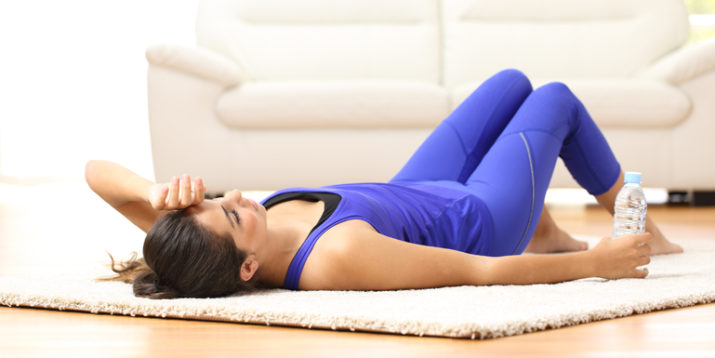6 Important Things to Do After Your Workout

So, you had an intense workout. You legs are shaking, your mouth is dry, and your shirt is drenched. All you want to do is collapse on the ground and not move until you stop wheezing and your face stops beating bright red.
But before you call it a day and throw in the sweat-soaked towel, there are a few crucial things you need to do to jumpstart your recovery process, prevent injury, and make sure you’re prepared for your next workout.
Don’t worry, these post-workout tips aren’t complicated and they won’t add too much time to your exercise regime. Plus, you may even seriously enjoy a few of them! (Hint: there’s chocolate involved.)
These six tips will help you cool down, refuel, and recharge after your workout so you can be ready to give it your all the following day.
1. Keep moving.
It’s tempting to just plop down on the couch or jump in the shower the second you finish your final rep, but our bodies need time to transition back to our natural resting state. That’s where the cool down comes into play.
There are two different ways to cool down – dynamically and statically. Dynamic cool downs keep your body moving, and include walking or light jogging. This helps lower your heart rate, reduce post-workout soreness, and promotes healthy blood circulation to carry nutrients and oxygen to the muscles you just exercised, says Meghan Kennihan, NASM Personal Trainer and RRCA and USAT Run Coach. She recommends five to 10 minutes of light jogging or walking after your workout.
2. Stretch and/or foam roll.
The second way to cool down is by doing static stretches. Your muscles are constantly contracting during exercise, which leaves them tight unless they’re properly stretched out. Too much tightness in your muscles can set you up for injury down the road.
Kennihan recommends doing some basic stretches for your back, chest, hips, quads, hamstrings, and calves for 30 seconds each after you finish exercising to loosen all your muscles.
To further reduce tension in your muscles, try foam rolling. “As you reduce tension, you’ll boost blood flow, which will help speed up recovery,” says Trevor Thieme, C.S.C.S. “Don’t just roll the muscles you targeted in your workout — give every muscle group at least five rolls, starting with your calves and working your way up your body.” Don’t have a foam roller yet? Get one here.
3. Hydrate.
“One of the most critical things to do after you workout is to rehydrate effectively and fully replenish any fluids and electrolytes lost,” says Priya Khorana, M.S. and ACSM-accredited Exercise Physiologist.
Water is the best option for hydration, but if you’re significantly dehydrated, Khorana recommends sipping a hydration formula to replenish your salt and electrolytes. Beachbody Performance Hydrate provides both electrolytes and carbohydrates to maximize absorption to keep you properly hydrated during and after your workouts.
4. Refuel.
How you refuel your body after a workout is key to the recovery process.
“Post-workout, your mission is to supply your muscles with the building blocks (amino acids) they need for repair and growth,” says Thieme.
Endurance athletes should also replenish glycogen, which Thieme describes as “the stored form of glucose — your body’s go-to fuel source.”
Beachbody Performance Recover is ideal for both these purposes. This post-workout supplement is full of fast-absorbing whey protein, pomegranate extract to help reduce exercise-induced soreness, and “just enough carbs to give you a head-start on glycogen resynthesis,” says Thieme.
If you want to eat whole foods after your workout, Denis Faye, M.S. and Beachbody Senior Director of Nutrition, says it’s important to eat something balanced with not too much fat. Think of tasty snacks like chocolate milk, a turkey sandwich, or cottage cheese with chickpeas.
5. Record your progress.
Before you mentally check out after a workout, take a couple minutes to record what you did. Along with specific details about what the workout entailed (heaviness of the weights, number of reps, distance, etc.), include notes about how you felt before, during, and after exercising.
“If you keep a workout journal, it helps you to figure out which exercises energize you, which drain you, and which are the best workouts for your body overall,” says Kennihan. “Also, if you get injured you can look back at your journal and see instances where you may have gone too hard or worked out through soreness or pain.”
If old-school journaling isn’t your style, invest in a watch, fitness monitor, or app that automatically tracks your workouts or lets you log your progress quickly. And if you’re an Apple Watch user, then you can track your caloric burn and heart rate during your workouts by connecting to the Beachbody On Demand app. It then stores the data for you to review later on.
6. Clean up.
Cleanliness isn’t usually high on the list of post-workout priorities — but it should be. Whether you work out at a gym or in your living room, exercise equipment like mats, benches, and weights can be breeding grounds for germs. Before you carry on with your day, and especially before you eat, take a few minutes to freshen up. Check out our tips for cleaning up and killing germs in your home gym.
